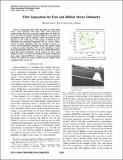| dc.contributor.author | Ni, Kai | |
| dc.contributor.author | Dellaert, Frank | |
| dc.contributor.author | Kaess, Michael | |
| dc.date.accessioned | 2010-10-19T16:01:00Z | |
| dc.date.available | 2010-10-19T16:01:00Z | |
| dc.date.issued | 2009-07 | |
| dc.identifier.isbn | 978-1-4244-2788-8 | |
| dc.identifier.issn | 1050-4729 | |
| dc.identifier.uri | http://hdl.handle.net/1721.1/59404 | |
| dc.description.abstract | Separating sparse flow provides fast and robust stereo visual odometry that deals with nearly degenerate situations that often arise in practical applications.We make use of the fact that in outdoor situations different constraints are provided by close and far structure, where the notion of close depends on the vehicle speed. The motion of distant features determines the rotational component that we recover with a robust two-point algorithm. Once the rotation is known, we recover the translational component from close features using a robust one-point algorithm. The overall algorithm is faster than estimating the motion in one step by a standard RANSAC-based three-point algorithm. And in contrast to other visual odometry work, we avoid the problem of nearly degenerate data, under which RANSAC is known to return inconsistent results. We confirm our claims on data from an outdoor robot equipped with a stereo rig. | en_US |
| dc.description.sponsorship | United States. Defense Advanced Research Projects Agency (grant FA8650-04-C-7131) | en_US |
| dc.language.iso | en_US | |
| dc.publisher | Institute of Electrical and Electronics Engineers | en_US |
| dc.relation.isversionof | http://dx.doi.org/10.1109/ROBOT.2009.5152333 | en_US |
| dc.rights | Article is made available in accordance with the publisher's policy and may be subject to US copyright law. Please refer to the publisher's site for terms of use. | en_US |
| dc.source | IEEE | en_US |
| dc.title | Flow separation for fast and robust stereo odometry | en_US |
| dc.type | Article | en_US |
| dc.identifier.citation | Kaess, M., Kai Ni, and F. Dellaert. “Flow separation for fast and robust stereo odometry.” Robotics and Automation, 2009. ICRA '09. IEEE International Conference on. 2009. 3539-3544. © 2009 IEEE | en_US |
| dc.contributor.department | Massachusetts Institute of Technology. Computer Science and Artificial Intelligence Laboratory | en_US |
| dc.contributor.department | Massachusetts Institute of Technology. Department of Mechanical Engineering | en_US |
| dc.contributor.approver | Kaess, Michael | |
| dc.contributor.mitauthor | Kaess, Michael | |
| dc.relation.journal | IEEE International Conference on Robotics and Automation, 2009. ICRA '09. | en_US |
| dc.eprint.version | Final published version | en_US |
| dc.type.uri | http://purl.org/eprint/type/JournalArticle | en_US |
| eprint.status | http://purl.org/eprint/status/PeerReviewed | en_US |
| dspace.orderedauthors | Kaess, M.; Kai Ni, M.; Dellaert, F. | en |
| mit.license | PUBLISHER_POLICY | en_US |
| mit.metadata.status | Complete | |
